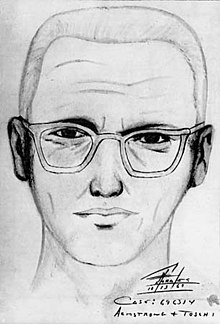
Back Sodiakmoordenaar Afrikaans زودياك السفاح Arabic زودياك السفاح ARZ Asesín del Zodiacu AST Zodiak (seriyalı qatil) Azerbaijani Задыяк (забойца) Byelorussian Зодиак (сериен убиец) Bulgarian জুদিয়াক (খুনি) Bengali/Bangla Zodíac (assassí) Catalan زۆدیاکی بکوژ CKB
Zodiac Killer | |
|---|---|
 Composite sketch made in 1969 based on eyewitness accounts of the Presidio Heights murder | |
| Criminal status | Unidentified |
| Motive | Uncertain |
| Wanted since | 1968 |
| Details | |
| Victims | 5 confirmed dead, 2 injured, possibly 20–28 total dead (claimed to have killed 37) |
Span of crimes | 1968–1969[n 1] |
| Country | United States |
| State(s) | California, possibly also Nevada |
| Location(s) | |
Date apprehended | Unapprehended |
The Zodiac Killer[n 2] is the pseudonym of an unidentified serial killer who operated in Northern California in the late 1960s.[n 1] The Zodiac murdered five known victims in the San Francisco Bay Area between December 1968 and October 1969, operating in rural, urban and suburban settings. He targeted three young couples and a lone male cab driver. The case has been described as "arguably the most famous unsolved murder case in American history", and has become both a fixture of popular culture and a focus for efforts by amateur detectives.
The Zodiac's known attacks took place in Benicia, Vallejo, unincorporated Napa County, and the city of San Francisco proper. Of his seven wounded victims, two survived. He coined his name in a series of taunting messages that he mailed to regional newspapers, in which he threatened killing sprees and bombings if they were not printed. Some of the letters included cryptograms, or ciphers, in which the killer claimed that he was collecting his victims as slaves for the afterlife. Of the four ciphers he produced, two remain unsolved, while the others were cracked in 1969 and 2020.
The last confirmed Zodiac letter was in 1974, when he claimed to have killed 37 victims. He claimed many of them were in Southern California, including Cheri Jo Bates, who was murdered in Riverside in 1966; a connection between the two has not been proven. While many theories regarding the identity of the Zodiac have been suggested, the only suspect authorities ever publicly named was Arthur Leigh Allen, a former elementary school teacher and convicted sex offender who died in 1992.
The unusual nature of the case led to international interest that has been sustained throughout the years. The San Francisco Police Department marked the case "inactive" in 2004, but re-opened it at some point prior to 2007. The case also remains open in the California Department of Justice, Federal Bureau of Investigation, the city of Vallejo, as well as in Napa and Solano counties.[1][2]
Cite error: There are <ref group=n> tags on this page, but the references will not show without a {{reflist|group=n}} template (see the help page).